u8g2reference
- C++/Arduino Example
-
Reference
- begin
- clear
- clearBuffer
- clearDisplay
- disableUTF8Print
- drawBitmap
- drawBox
- drawButtonUTF8
- drawCircle
- drawDisc
- drawEllipse
- drawFilledEllipse
- drawFrame
- drawGlyph
- drawHLine
- drawLine
- drawPixel
- drawRBox
- drawRFrame
- drawStr
- drawTriangle
- drawUTF8
- drawVLine
- drawXBM
- drawXBMP
- enableUTF8Print
- firstPage
- getAscent
- getDescent
- getDisplayHeight
- getDisplayWidth
- getMaxCharHeight
- getMaxCharWidth
- getMenuEvent
- getStrWidth
- getU8g2
- getU8x8
- getUTF8Width
- home
- initDisplay
- initInterface
- nextPage
- sendBuffer
- sendF
- setAutoPageClear
- setBitmapMode
- setBusClock
- setClipWindow
- setContrast
- setCursor
- setDisplayRotation
- setDrawColor
- setFlipMode
- setFont
- setFontDirection
- setFontMode
- setFontPosBaseline
- setFontPosBottom
- setFontPosTop
- setFontPosCenter
- setFontRefHeightAll
- setFontRefHeightExtendedText
- setFontRefHeightText
- setI2CAddress
- setMaxClipWindow
- setPowerSave
- updateDisplay
- updateDisplayArea
- userInterfaceInputValue
- userInterfaceMessage
- userInterfaceSelectionList
- writeBufferPBM
- writeBufferPBM2
- writeBufferXBM
- writeBufferXBM2
- Direct Access Buffer API
#include <Arduino.h>
#include <SPI.h>
#include <U8g2lib.h>
U8G2_SSD1306_128X64_NONAME_1_4W_SW_SPI u8g2(U8G2_R0, /* clock=*/ 13, /* data=*/ 11, /* cs=*/ 10, /* dc=*/ 9, /* reset=*/ 8);
void setup(void) {
u8g2.begin();
}
void loop(void) {
u8g2.firstPage();
do {
u8g2.setFont(u8g2_font_ncenB14_tr);
u8g2.drawStr(0,15,"Hello World!");
} while ( u8g2.nextPage() );
delay(1000);
}
The first argument of the constructor assignes the basic layout for the display:
| Layout | Description |
|---|---|
U8G2_R0 |
No rotation, landscape |
U8G2_R1 |
90 degree clockwise rotation |
U8G2_R2 |
180 degree clockwise rotation |
U8G2_R3 |
270 degree clockwise rotation |
U8G2_MIRROR |
No rotation, landscape, display content is mirrored (v2.6.x) |
U8G2_MIRROR_VERTICAL |
Display content is vertically mirrored (v2.29.x) |
All other arguments descibe the wiring of the display.
Available constructors are listed in the setup guide.
Note: U8G2_MIRROR works together with setFlipMode.
- C++/Arduino Prototype:
bool U8G2::begin(void)
bool U8G2::begin(uint8_t menu_select_pin, uint8_t menu_next_pin, uint8_t menu_prev_pin, uint8_t menu_up_pin = U8X8_PIN_NONE, uint8_t menu_down_pin = U8X8_PIN_NONE, uint8_t menu_home_pin = U8X8_PIN_NONE)
-
Description: Simplified setup procedure of the display for the Arduino enviornment.
See the setup guide for the selection of a suitable U8g2 constructor.
This function will reset, configure, clear and disable power save mode of
the display.
U8g2 can also detect key press events. Up to six buttons can be observed. The Arduino pin number
can be assigned here. Use
U8X8_PIN_NONEif there is no switch connected to the pin. The switch has to connect the GPIO pin with GND (low active button). Use getMenuEvent to check for any key press event. Select, next and prev pins are also required for the user interface procedures (for example userInterfaceMessage ).beginwill call
- Arguments: -
- Returns: Always 1/true
- See also: initDisplay setPowerSave clearDisplay U8X8::begin
- Example:
void setup(void) {
u8g2.begin();
}
void loop(void) {
u8g2.firstPage();
do {
u8g2.setFont(u8g2_font_ncenB14_tr);
u8g2.drawStr(0,15,"Hello World!");
} while ( u8g2.nextPage() );
delay(1000);
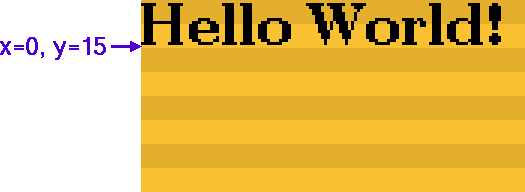
- C++/Arduino Prototype:
void U8G2::clear(void)
-
Description: Clears all pixel on the display and the buffer. Puts the cursor for the print function into the upper left corner.
clearwill call
- Arguments:
- Returns: -
- See also: print home clearBuffer
- C++/Arduino Prototype:
void U8G2::clearBuffer(void)
- C Prototype:
void u8g2_ClearBuffer(u8g2_t *u8g2);
- Description: Clears all pixel in the memory frame buffer. Use sendBuffer to transfer the cleared frame buffer to the display. In most cases, this procedure is useful only with a full frame buffer in the RAM of the microcontroller (Constructor with buffer option "f", see here). This procedure will also send a refresh message (refreshDisplay) to an e-Paper/e-Ink device.
-
Arguments:
-
u8g2: A pointer to the u8g2 structure.
-
- Returns: -
- See also: sendBuffer
- Example:
void loop(void) {
u8g2.clearBuffer();
// ... write something to the buffer
u8g2.sendBuffer();
delay(1000);
- C++/Arduino Prototype:
void U8G2::clearDisplay(void)
- C Prototype:
void u8g2_ClearDisplay(u8g2_t *u8g2);
- Description: Clears all pixel in the internal buffer AND on the connected display. This procedure is also called from begin. Usually there is no need to call this function except for the init procedure. Other procedures like sendBuffer and nextPage will also overwrite (and clear) the display.
-
Arguments:
-
u8g2: A pointer to the u8g2 structure.
-
- Returns: -
- Notes:
- See also: begin
- C++/Arduino Prototype:
void U8G2::disableUTF8Print(void)
-
Description: Disables UTF8 support for the Arduino
printfunction. This is also the default setting. - Arguments: -
- Returns: -
- See also: print, enableUTF8Print
- C++/Arduino:
void U8G2::drawBitmap(u8g2_uint_t x, u8g2_uint_t y, u8g2_uint_t cnt, u8g2_uint_t h, const uint8_t *bitmap)
- C:
void u8g2_DrawBitmap(u8g2_t *u8g2, u8g2_uint_t x, u8g2_uint_t y, u8g2_uint_t cnt, u8g2_uint_t h, const uint8_t *bitmap)
-
Description: Draw a bitmap at the specified x/y position (upper left corner of the bitmap). Parts of the bitmap may be outside the display boundaries.The bitmap is specified by the array
bitmap. A cleared bit means: Do not draw a pixel. A set bit inside the array means: Write pixel with the current color index.For a monochrome display, the color index 0 will clear a pixel (in solid mode) and the color index 1 will set a pixel. -
Arguments:
-
u8g2: Pointer to theu8g2structure (C interface only). -
x: X-position (left position of the bitmap). -
y: Y-position (upper position of the bitmap). -
cnt: Number of bytes of the bitmap in horizontal direction. The width of the bitmap iscnt*8. -
h: Height of the bitmap.
-
- Returns:-
- Note: This function should not be used any more, please use drawXBM instead.
- See also: drawXBM setBitmapMode
- C++/Arduino:
void U8G2::drawBox(u8g2_uint_t x, u8g2_uint_t y, u8g2_uint_t w, u8g2_uint_t h)
- C:
void u8g2_DrawBox(u8g2_t *u8g2, u8g2_uint_t x, u8g2_uint_t y, u8g2_uint_t w, u8g2_uint_t h)
-
Description: Draw a box (filled frame), starting at x/y position (upper left edge). The box has width
wand heighth. Parts of the box can be outside of the display boundaries. This procedure will use the current color (setDrawColor) to draw the box. For a monochrome display, the color index 0 will clear a pixel and the color index 1 will set a pixel. -
Arguments:
-
u8g2: Pointer to theu8g2structure (C interface only). -
x: X-position of upper left edge. -
y: Y-position of upper left edge. -
w: Width of the box. -
h: Height of the box.
-
- Returns:
- See also: drawFrame setDrawColor
- Example:
u8g2.drawBox(3,7,25,15);
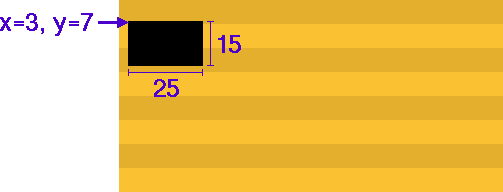
- C++/Arduino:
void U8G2::drawButtonUTF8(u8g2_uint_t x, u8g2_uint_t y, u8g2_uint_t flags, u8g2_uint_t width, u8g2_uint_t padding_h, u8g2_uint_t padding_v, const char *text)
- C:
void u8g2_DrawButtonUTF8(u8g2_t *u8g2, u8g2_uint_t x, u8g2_uint_t y, u8g2_uint_t flags, u8g2_uint_t width, u8g2_uint_t padding_h, u8g2_uint_t padding_v, const char *text)
- Description: Draw a frame / box around a provided text. This is similar to drawUTF8, but adds some decoration to the text.
| Flag | Description |
|---|---|
U8G2_BTN_BW0 |
No frame around the text |
U8G2_BTN_BW1 |
Frame around the text, 1 pixel border width |
U8G2_BTN_BW2 |
Frame around the text, 2 pixel border width |
U8G2_BTN_BW3 |
Frame around the text, 3 pixel border width |
U8G2_BTN_SHADOW0 |
Enable shadow, no gap to the frame |
U8G2_BTN_SHADOW1 |
Enable shadow, 1 pixel gap to the frame |
U8G2_BTN_SHADOW2 |
Enable shadow, 2 pixel gap to the frame |
U8G2_BTN_INV |
Invert the text |
U8G2_BTN_HCENTER |
Center the text inside the frame and change the reference position to the center of the text |
U8G2_BTN_XFRAME |
Draw second 1-pixel frame around the button |
-
Arguments:
-
u8g2: Pointer to theu8g2structure (C interface only). -
x,y: Position of the first character on the display. IfU8G2_BTN_HCENTERis used, then this is the center position of the text. -
flags: See table above. Multiple flags can be used with the "or" operator. -
width: Minimum width of the text. If 0 (or lower than the text width), then the text width is used for the frame. -
padding_h: Extra space before and after the text. -
padding_v: Extra space above and below the text. -
text: UTF8 encoded string which will be drawn on the display.
-
- Returns:
- Note: Font mode is set to 1 by this function (see setFontMode)
- See also: setFont drawUTF8
-
Example 1: Left adjusted text with 2 pixel space (
padding_h=2andpadding_v=2) around the text and a 2 pixel border (BW2).
u8g2.setFont(u8g2_font_helvR08_tr);
u8g2.drawButtonUTF8(62, 20, U8G2_BTN_BW2, 0, 2, 2, "Btn" );

- Example 2: Centered text
u8g2.setFont(u8g2_font_helvR08_tr);
u8g2.drawButtonUTF8(62, 20, U8G2_BTN_HCENTER|U8G2_BTN_BW2, 34, 2, 2, "Btn" );
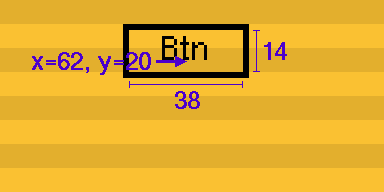
- Example 3: Centered text with shadow. Note: The shadow thickness is always equal to the frame border width. The gap between frame and shadow is specified by the flag.
u8g2.setFont(u8g2_font_helvR08_tr);
u8g2.drawButtonUTF8(62, 20, U8G2_BTN_SHADOW1|U8G2_BTN_HCENTER|U8G2_BTN_BW2, 34, 2, 2, "Btn" );
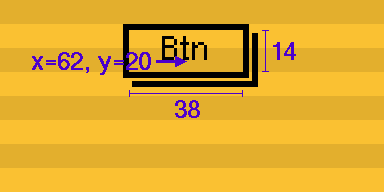
- Example 4: Left adjusted text with 2 pixel space around the text. The text (including the 2 pixel space) is inverted.
u8g2.setFont(u8g2_font_helvR08_tr);
u8g2.drawButtonUTF8(62, 20, U8G2_BTN_INV, 0, 2, 2, "Btn" );

- Example 5: Left adjusted inverted text with 2 pixel space and 2 pixel border. The border is just added around the pixel space.
u8g2.setFont(u8g2_font_helvR08_tr);
u8g2.drawButtonUTF8(62, 20, U8G2_BTN_INV|U8G2_BTN_BW2, 0, 2, 2, "Btn" );

-
Example 6: Text at position
(5, 20)within a full display width inverted bar: The text width is expanded tou8g2.getDisplayWidth()-5*2pixel. Then another 5 pixel space is added before and after the text (total width:5+u8g2.getDisplayWidth()-5*2+5).
u8g2.setFont(u8g2_font_helvR08_tr);
u8g2.drawButtonUTF8(5, 20, U8G2_BTN_INV, u8g2.getDisplayWidth()-5*2, 5, 2, "Btn" );
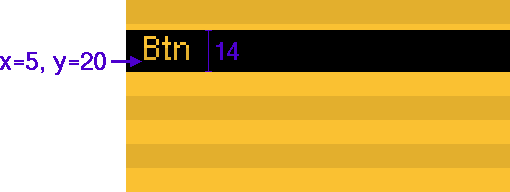
- C++/Arduino:
void U8G2::drawCircle(u8g2_uint_t x0, u8g2_uint_t y0, u8g2_uint_t rad, uint8_t opt = U8G2_DRAW_ALL)
- C:
void u8g2_DrawCircle(u8g2_t *u8g2, u8g2_uint_t x0, u8g2_uint_t y0, u8g2_uint_t rad, uint8_t opt)
-
Description: Draw a circle with radus
radat position(x0, y0). The diameter of the circle is2*rad+1. Depending onopt, it is possible to draw only some sections of the circle. Possible values foroptare:U8G2_DRAW_UPPER_RIGHT,U8G2_DRAW_UPPER_LEFT,U8G2_DRAW_LOWER_LEFT,U8G2_DRAW_LOWER_RIGHT,U8G2_DRAW_ALL. These values can be combined with the|operator. This procedure will use the current color (setDrawColor) for drawing. -
Arguments:
-
u8g2: Pointer to theu8g2structure (C interface only). -
x0,y0: Position of the center of the circle. -
rad: Defines the size of the circle: Radus =rad. -
opt: Selects some or all sections of the circle.U8G2_DRAW_UPPER_RIGHTU8G2_DRAW_UPPER_LEFTU8G2_DRAW_LOWER_LEFTU8G2_DRAW_LOWER_RIGHTU8G2_DRAW_ALL
-
- Returns:
- Note: Draw color 2 (XOR Mode) is not supported.
- See also: drawDisc setDrawColor
- Example:
u8g2.drawCircle(20, 25, 10, U8G2_DRAW_ALL);
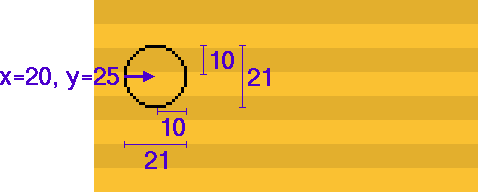
- C++/Arduino:
void U8G2::drawDisc(u8g2_uint_t x0, u8g2_uint_t y0, u8g2_uint_t rad, uint8_t opt = U8G2_DRAW_ALL)
- C:
void u8g2_DrawDisc(u8g2_t *u8g2, u8g2_uint_t x0, u8g2_uint_t y0, u8g2_uint_t rad, uint8_t opt)
-
Description: Draw a filled circle with radus
radat position(x0, y0). The diameter of the circle is2*rad+1. Depending onopt, it is possible to draw only some sections of the disc. Possible values foroptare:U8G2_DRAW_UPPER_RIGHT,U8G2_DRAW_UPPER_LEFT,U8G2_DRAW_LOWER_LEFT,U8G2_DRAW_LOWER_RIGHT,U8G2_DRAW_ALL. These values can be combined with the|operator. This procedure will use the current color (setDrawColor) for drawing. -
Arguments:
-
u8g2: Pointer to theu8g2structure (C interface only). -
x0,y0: Position of the center of the disc. -
rad: Defines the size of the circle: Radus =rad. -
opt: Selects some or all sections of the disc.U8G2_DRAW_UPPER_RIGHTU8G2_DRAW_UPPER_LEFTU8G2_DRAW_LOWER_LEFTU8G2_DRAW_LOWER_RIGHTU8G2_DRAW_ALL
-
- Returns:
- Note: Draw color 2 (XOR Mode) is not supported.
- See also: drawCircle setDrawColor
- Example: See drawCircle
- C++/Arduino:
void U8G2::drawEllipse(u8g2_uint_t x0, u8g2_uint_t y0, u8g2_uint_t rx, u8g2_uint_t ry, uint8_t opt)
- C:
void u8g2_DrawEllipse(u8g2_t *u8g2, u8g2_uint_t x0, u8g2_uint_t y0, u8g2_uint_t rx, u8g2_uint_t ry, uint8_t opt)
-
Description: Draw ellipse with radus
rxand 'ry' at position(x0, y0).rx*rymust be lower than 512 in 8 Bit mode of u8g2.
Depending onopt, it is possible to draw only some sections of the disc. Possible values foroptare:U8G2_DRAW_UPPER_RIGHT,U8G2_DRAW_UPPER_LEFT,U8G2_DRAW_LOWER_LEFT,U8G2_DRAW_LOWER_RIGHT,U8G2_DRAW_ALL. These values can be combined with the|operator. The diameter is twice the radius plus one. -
Arguments:
-
u8g2: Pointer to theu8g2structure (C interface only). -
x0,y0: Position of the center of the filled circle. -
rx,ry: Defines the size of the ellipse. -
opt: Selects some or all sections of the ellipse.U8G2_DRAW_UPPER_RIGHTU8G2_DRAW_UPPER_LEFTU8G2_DRAW_LOWER_LEFTU8G2_DRAW_LOWER_RIGHTU8G2_DRAW_ALL
-
- Returns:
- Note: Draw color 2 (XOR Mode) is not supported.
- See also: drawCircle
- Example:
u8g2.drawEllipse(20, 25, 15, 10, U8G2_DRAW_ALL);
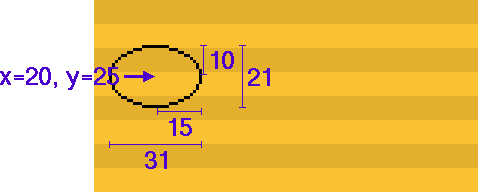
void U8G2::drawFilledEllipse(u8g2_uint_t x0, u8g2_uint_t y0, u8g2_uint_t rx, u8g2_uint_t ry, uint8_t opt)
- C:
void u8g2_DrawFilledEllipse(u8g2_t *u8g2, u8g2_uint_t x0, u8g2_uint_t y0, u8g2_uint_t rx, u8g2_uint_t ry, uint8_t opt)
-
Description: Draw a filled ellipse with radus
rxand 'ry' at position(x0, y0).rx*rymust be lower than 512 in 8 Bit mode of u8g2.Depending onopt, it is possible to draw only some sections of the disc. Possible values foroptare:U8G2_DRAW_UPPER_RIGHT,U8G2_DRAW_UPPER_LEFT,U8G2_DRAW_LOWER_LEFT,U8G2_DRAW_LOWER_RIGHT,U8G2_DRAW_ALL.These values can be combined with the|operator. -
Arguments:
-
u8g2: Pointer to theu8g2structure (C interface only). -
x0,y0: Position of the center of the filled circle. -
rx,ry: Defines the size of the ellipse. -
opt: Selects some or all sections of the ellipse.U8G2_DRAW_UPPER_RIGHTU8G2_DRAW_UPPER_LEFTU8G2_DRAW_LOWER_LEFTU8G2_DRAW_LOWER_RIGHTU8G2_DRAW_ALL
-
- Returns:
- Note: Draw color 2 (XOR Mode) is not supported.
- See also: drawCircle
- Example: drawEllipse
- C++/Arduino:
void U8G2::drawFrame(u8g2_uint_t x, u8g2_uint_t y, u8g2_uint_t w, u8g2_uint_t h)
- C:
void u8g2_DrawFrame(u8g2_t *u8g2, u8g2_uint_t x, u8g2_uint_t y, u8g2_uint_t w, u8g2_uint_t h)
-
Description: Draw a frame (empty box), starting at x/y position (upper left edge). The box has width
wand heighth. Parts of the frame can be outside of the display boundaries. This procedure will use the current color (setDrawColor) to draw the box. For a monochrome display, the color index 0 will clear a pixel and the color index 1 will set a pixel. -
Arguments:
-
u8g2: Pointer to theu8g2structure (C interface only). -
x: X-position of upper left edge. -
y: Y-position of upper left edge. -
w: Width of the frame. -
h: Height of the frame.
-
- Returns:
- See also: drawBox setDrawColor getStrWidth
- Example 1: getStrWidth includes an example for drawing a frame around a string.
- Example 2:
u8g2.drawFrame(3,7,25,15);

- C++/Arduino Prototype:
u8g2_uint_t U8G2::drawGlyph(u8g2_uint_t x, u8g2_uint_t y, uint16_t encoding)
u8g2_uint_t U8G2::drawGlyphX2(u8g2_uint_t x, u8g2_uint_t y, uint16_t encoding)
- C Prototype:
u8g2_uint_t u8g2_DrawGlyph(u8g2_t *u8g2, u8g2_uint_t x, u8g2_uint_t y, uint16_t encoding);
u8g2_uint_t u8g2_DrawGlyphX2(u8g2_t *u8g2, u8g2_uint_t x, u8g2_uint_t y, uint16_t encoding);
-
Description: Draw a single character.
The character is placed at the specified pixel posion
xandy. U8g2 supports the lower 16 bit of the unicode character range (plane 0/Basic Multilingual Plane): Theencodingcan be any value from 0 to 65535. The glyph can be drawn only, if the encoding exists in the active font. TheX2variant of this function will double the size of the glyph but will ignore the font direction setting. -
Arguments:
-
u8g2: A pointer to the u8g2 structure. -
x,y: Position of the character on the display. -
encoding: Unicode value of the character.
-
- Returns: Width of the character.
- Note: This drawing function depends on the current font mode and drawing color.
- See also: setFont
-
Example: The "snowman" glyph is part of the unicode weather symbols and
has the unicode 9731 (dezimal) / 2603 (hex): "☃".
The "snowman" is also part of the u8g2 font
u8g2_font_unifont_t_symbols(see below).
u8g2.setFont(u8g2_font_unifont_t_symbols);
u8g2.drawGlyph(5, 20, 0x2603); /* dec 9731/hex 2603 Snowman */
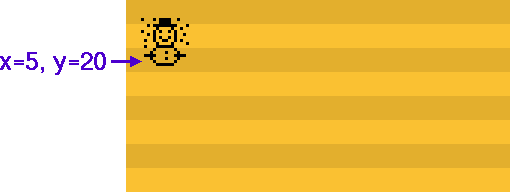
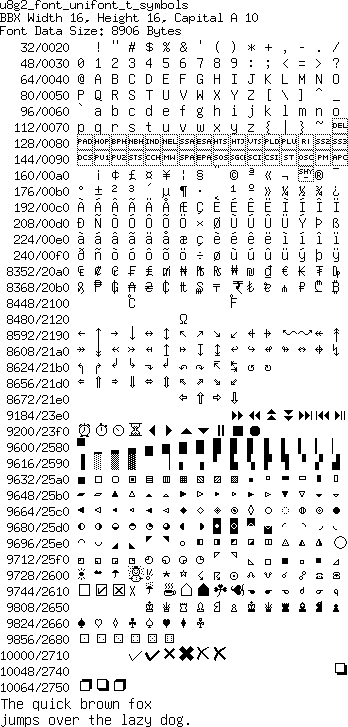
- C++/Arduino:
void U8G2::drawHLine(u8g2_uint_t x, u8g2_uint_t y, u8g2_uint_t w)
- C:
void u8g2_DrawHLine(u8g2_t *u8g2, u8g2_uint_t x, u8g2_uint_t y, u8g2_uint_t w)
-
Description: Draw a horizontal line, starting at x/y position (left edge). The width (length) of the line is
wpixel. Parts of the line can be outside of the display boundaries. This procedure uses the current color index to draw the line. Color index 0 will clear a pixel and the color index 1 will set a pixel. -
Arguments:
-
u8g2: Pointer to theu8g2structure (C interface only). -
x: X-position. -
y: Y-position. -
w: Length of the horizontal line.
-
- Returns: -
- See also: setDrawColor, drawVLine
- C++/Arduino:
void U8G2::drawLine(u8g2_uint_t x0, u8g2_uint_t y0, u8g2_uint_t x1, u8g2_uint_t y1)
- C:
void u8g2_DrawLine(u8g2_t *u8g2, u8g2_uint_t x0, u8g2_uint_t y0, u8g2_uint_t x1, u8g2_uint_t y1)
- Description: Draw a line between two points. This procedure will use the current color (setDrawColor).
-
Arguments:
-
u8g2: Pointer to theu8g2structure (C interface only). -
x0: X-position of the first point. -
y0: Y-position of the first point. -
x1: X-position of the second point. -
y1: Y-position of the second point.
-
- Returns:
- See also: drawPixel setDrawColor
- Example:
u8g2.drawLine(20, 5, 5, 32);
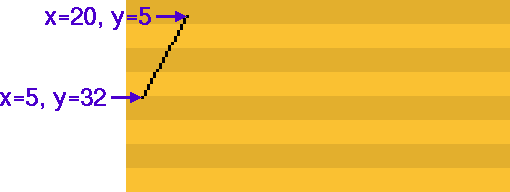
- C++/Arduino:
void U8G2::drawPixel(u8g2_uint_t x, u8g2_uint_t y)
- C:
void u8g2_DrawPixel(u8g2_t *u8g2, u8g2_uint_t x, u8g2_uint_t y)
- Description: Draw a pixel at the specified x/y position. Position (0,0) is at the upper left corner of the display. The position may be outside the display boundaries.This procedure uses the current color index to draw the pixel. The color index 0 will clear a pixel and the color index 1 will set a pixel.
-
Arguments:
-
u8g2: Pointer to theu8g2structure (C interface only). -
x: X-position. -
y: Y-position.
-
- Returns:
- See also: setDrawColor
- C++/Arduino:
void U8G2::drawRBox(u8g2_uint_t x, u8g2_uint_t y, u8g2_uint_t w, u8g2_uint_t h, u8g2_uint_t r)
void U8G2::drawRFrame(u8g2_uint_t x, u8g2_uint_t y, u8g2_uint_t w, u8g2_uint_t h, u8g2_uint_t r)
- C:
void u8g2_DrawRBox(u8g2_t *u8g2, u8g2_uint_t x, u8g2_uint_t y, u8g2_uint_t w, u8g2_uint_t h, u8g2_uint_t r)
void u8g2_DrawRFrame(u8g2_t *u8g2, u8g2_uint_t x, u8g2_uint_t y, u8g2_uint_t w, u8g2_uint_t h, u8g2_uint_t r)
-
Description: Draw a box/frame with round edges, starting at x/y position (upper left edge). The box/frame has width
wand heighth. Parts of the box can be outside of the display boundaries. Edges have radiusr. It is required thatw >= 2*(r+1)andh >= 2*(r+1). This condition is not checked. Behavior is undefined ifworhis smaller than2*(r+1). This procedure uses the current color index to draw the box. For a monochrome display, the color index 0 will clear a pixel and the color index 1 will set a pixel. -
Arguments:
-
u8g2: Pointer to theu8g2structure (C interface only). -
x: X-position of upper left edge. -
y: Y-position of upper left edge. -
w: Width of the box. -
h: Height of the box. -
r: Radius for the four edges.
-
- Returns: -
- See also: setDrawColor, drawFrame, drawBox
- Example:
u8g2.drawRFrame(20,15,30,22,7);

- C++/Arduino Prototype:
u8g2_uint_t U8g2::drawStr(u8g2_uint_t x, u8g2_uint_t y, const char *s)
u8g2_uint_t U8g2::drawStrX2(u8g2_uint_t x, u8g2_uint_t y, const char *s)
- C Prototype:
u8g2_uint_t u8g2_DrawStr(u8g2_t *u8g2, u8g2_uint_t x, u8g2_uint_t y, const char *s);
u8g2_uint_t u8g2_DrawStrX2(u8g2_t *u8g2, u8g2_uint_t x, u8g2_uint_t y, const char *s);
-
Description: Draw a string. The first character is placed at position
xandy. Use setFont to assign a font before drawing a string on the display. To draw a character with encoding 127 to 255, use the C/C++/Arduino escape sequence "\xab" (hex value ab) or "\xyz" (octal value xyz). This function can not draw any glyph with encoding greater or equal to 256. Use drawUTF8 or drawGlyph to access glyphs with encoding greater or equal to 256. TheX2variant will double the size of the sting but will ignore the font direction setting. -
Arguments:
-
u8g2: A pointer to the u8g2 structure. -
x,y: Position of the first character on the display. -
s: Text.
-
- Returns: Width of the string.
- Note 1: This drawing function depends on the current font mode and drawing color.
- Note 2: Use the print function to print the value of a numeric variable.
- See also: setFont drawUTF8 drawGlyph print
- Example:
u8g2.setFont(u8g2_font_ncenB14_tr);
u8g2.drawStr(0,15,"Hello World!");

- C++/Arduino:
void U8G2::drawTriangle(int16_t x0, int16_t y0, int16_t x1, int16_t y1, int16_t x2, int16_t y2)
- C:
void u8g2_DrawTriangle(u8g2_t *u8g2, int16_t x0, int16_t y0, int16_t x1, int16_t y1, int16_t x2, int16_t y2)
- Description: Draw a triangle (filled polygon). Arguments are 16 bit and the polygon is clipped to the size of the display. Multiple polygons are drawn so that they exactly match without overlap:The left side of a polygon is drawn, the right side is not draw. The upper side is only draw if it is flat.
-
Arguments:
-
u8g2: Pointer to theu8g2structure (C interface only). -
x0: X-position point 0. -
y0: Y-position point 0. -
x1: X-position point 1. -
y1: Y-position point 1. -
x2: X-position point 2. -
y2: Y-position point 2.
-
- Returns: -
- Example:
u8g2.drawTriangle(20,5, 27,50, 5,32);
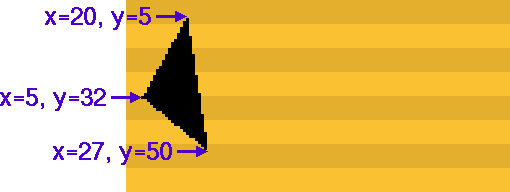
- C++/Arduino Prototype:
u8g2_uint_t U8g2::drawUTF8(u8g2_uint_t x, u8g2_uint_t y, const char *s)
u8g2_uint_t U8g2::drawUTF8X2(u8g2_uint_t x, u8g2_uint_t y, const char *s)
- C Prototype:
u8g2_uint_t u8g2_DrawUTF8(u8g2_t *u8g2, u8g2_uint_t x, u8g2_uint_t y, const char *s);
u8g2_uint_t u8g2_DrawUTF8X2(u8g2_t *u8g2, u8g2_uint_t x, u8g2_uint_t y, const char *s);
-
Description: Draw a string which is encoded as UTF-8. There are two
preconditions for the use of this function: (A) the C/C++/Arduino compiler must support
UTF-8 encoding (this is default for the gnu compiler, which is also used for
most Arduino boards) and (B) the code editor/IDE must support and store the
C/C++/Arduino code as UTF-8 (true for the Arduino IDE). If these conditions are met,
you can use the character with code value greater than 127 directly in the string
(of course the character must
exist in the font file, see also setFont).
Advantage: No escape codes are required
and the source code is more readable. The glyph can be copied and paste into the
editor from a "char set" tool. Disadvantage: The code is less portable
and the
strlenfunction will not return the number of visible characters. Use getUTF8Len instead ofstrlen. TheX2variant will double the size of the UTF8 sting but will ignore the font direction setting. -
Arguments:
-
u8g2: A pointer to the u8g2 structure. -
x,y: Position of the first character on the display. -
s: UTF-8 encoded text.
-
- Returns: Width of the string.
- Note 1: This drawing function depends on the current font mode and drawing color.
- Note 2: Use the print function to print the value of a numeric variable.
- See also: setFont drawStr print
- Example:
u8g2.setFont(u8g2_font_unifont_t_symbols);
u8g2.drawUTF8(5, 20, "Snowman: ☃");
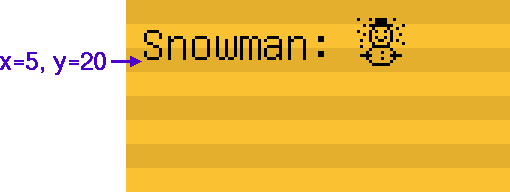
- C++/Arduino:
void U8G2::drawVLine(u8g2_uint_t x, u8g2_uint_t y, u8g2_uint_t h)
- C:
void u8g2_DrawVLine(u8g2_t *u8g2, u8g2_uint_t x, u8g2_uint_t y, u8g2_uint_t h)
-
Description: Draw a vertical line, starting at x/y position (upper end). The height (length) of the line is
hpixel. Parts of the line can be outside of the display boundaries. This procedure uses the current color index to draw the line. Color index 0 will clear a pixel and the color index 1 will set a pixel. -
Arguments:
-
u8g2: Pointer to theu8g2structure (C interface only). -
x: X-position. -
y: Y-position. -
h: Length of the vertical line.
-
- Returns: -
- See also: setDrawColor, drawHLine
- C++/Arduino:
void U8G2::drawXBM(u8g2_uint_t x, u8g2_uint_t y, u8g2_uint_t w, u8g2_uint_t h, const uint8_t *bitmap)
void U8G2::drawXBMP(u8g2_uint_t x, u8g2_uint_t y, u8g2_uint_t w, u8g2_uint_t h, const uint8_t *bitmap)
- C:
void u8g2_DrawXBM(u8g2_t *u8g2, u8g2_uint_t x, u8g2_uint_t y, u8g2_uint_t w, u8g2_uint_t h, const uint8_t *bitmap)
void u8g2_DrawXBMP(u8g2_t *u8g2, u8g2_uint_t x, u8g2_uint_t y, u8g2_uint_t w, u8g2_uint_t h, const uint8_t *bitmap)
-
Description: Draw a XBM Bitmap. Position (x,y) is the upper left corner of the bitmap.
XBM contains monochrome, 1-bit bitmaps.
The current color index is used for drawing (see setColorIndex) pixel values 1. Version 2.15.x of U8g2 introduces a solid and a transparent mode for bitmaps. By default, drawXBM will draw solid bitmaps. This differs from the previous versions: Use setBitmapMode(1) to switch to the previous behavior. The XBMP version of this procedure expects the bitmap to be in PROGMEM area (AVR only). Many tools (including GIMP) can save a bitmap as XBM. A nice video instruction is here (external link). The result will look like this:
Example:
#define u8g_logo_width 38
#define u8g_logo_height 24
static unsigned char u8g_logo_bits[] = {
0xff, 0xff, 0xff, 0xff, 0x3f, 0xff, 0xff, 0xff, 0xff, 0x3f, 0xe0, 0xe0,
...
0xff, 0x3f, 0xff, 0xff, 0xff, 0xff, 0x3f, 0xff, 0xff, 0xff, 0xff, 0x3f };
This could can be copied directly into your code. Use drawXBM to draw this bitmap at (0,0):
u8g2.drawXBM( 0, 0, u8g_logo_width, u8g_logo_height, u8g_logo_bits);
-
Arguments:
-
u8g2: Pointer to theu8g2structure (C interface only). -
x: X-position. -
y: Y-position. -
w: Width of the bitmap. -
h: Height of the bitmap. -
bitmap: Pointer to the start of the bitmap.
-
- Returns:
- See also: setBitmapMode
- Note: The XBMP version requires, that the bitmap array is defined in this way:
static const unsigned char u8g_logo_bits[] U8X8_PROGMEM = { ...
- C++/Arduino Prototype:
void U8G2::enableUTF8Print(void)
-
Description: Activates UTF8 support for the Arduino
printfunction. When activated, unicode symbols are allowed for strings passed to theprintfunction. Usually this function is called afterbegin():
void setup(void) {
u8g2.begin();
u8g2.enableUTF8Print(); // enable UTF8 support for the Arduino print()
}
- Arguments: -
- Returns: -
- See also: print, disableUTF8Print
- Example:
void setup(void) {
u8g2.begin();
u8g2.enableUTF8Print(); // enable UTF8 support for the Arduino print() function
}
void loop(void) {
u8g2.setFont(u8g2_font_unifont_t_chinese2); // use chinese2 for all the glyphs of "你好世界"
u8g2.firstPage();
do {
u8g2.setCursor(0, 40);
u8g2.print("你好世界"); // Chinese "Hello World"
} while ( u8g2.nextPage() );
delay(1000);
}
- C++/Arduino Prototype:
void U8G2::firstPage(void)
- C Prototype:
void u8g2_FirstPage(u8g2_t *u8g2);
- Description: This command is part of the (picture) loop which renders the content of the display. This command must be used together with nextPage. There are some restrictions: Do not change the content when executing this loop. Always redraw everything. It is not possible to redraw only parts of the content. The advantage is lesser RAM consumption compared to a full frame buffer in RAM, see sendBuffer.
-
Arguments:
-
u8g2: A pointer to the u8g2 structure.
-
- Returns: -
- Note: This procedure sets the current page position to zero.
- See also: nextPage
- Example:
u8g2.firstPage();
do {
/* all graphics commands have to appear within the loop body. */
u8g2.setFont(u8g2_font_ncenB14_tr);
u8g2.drawStr(0,20,"Hello World!");
} while ( u8g2.nextPage() );
- C++/Arduino:
int8_t U8G2::getAscent(void)
- C:
int8_t u8g2_GetAscent(u8g2_t *u8g)
- Description: Returns the reference height of the glyphs above the baseline (ascent). This value depends on the current reference height (see setFontRefHeightAll).
-
Arguments:
-
u8g2: Pointer to theu8g2structure (C interface only).
-
- Returns: The ascent of the current font.
- See also: setFont getDescent setFontRefHeightAll
-
Example: In the picture below, the ascent is 18 and the descent value is -5 (minus 5!).

- C++/Arduino:
int8_t U8G2::getDescent(void)
- C:
int8_t u8g2_GetDescent(u8g2_t *u8g2)
- Description: Returns the reference height of the glyphs below the baseline (descent). For most fonts, this value will be negative. This value depends on the current reference height (see setFontRefHeightAll).
-
Arguments:
-
u8g2: Pointer to theu8g2structure (C interface only).
-
- Returns: The descent of the current font.
- See also: setFont getDescent setFontRefHeightAll
-
Example: In the picture below, the ascent is 18 and the descent value is -5 (minus 5!).

- C++/Arduino:
u8g2_uint_t getDisplayHeight(void)
- C:
u8g2_uint_t u8g2_GetDisplayHeight(u8g2_t *u8g2)
- Description: Returns the height of the display.
-
Arguments:
-
u8g2: Pointer to theu8g2structure (C interface only).
-
- Returns: The height of the display.
- See also: getDisplayWidth
- Example: -
- C++/Arduino:
u8g2_uint_t getDisplayWidth(void)
- C:
u8g2_uint_t u8g2_GetDisplayWidth(u8g2_t *u8g2)
- Description: Returns the width of the display.
-
Arguments:
-
u8g2: Pointer to theu8g2structure (C interface only).
-
- Returns: The width of the display.
- See also: getDisplayHeight
- Example: -
- C++/Arduino:
u8g2_uint_t getMaxCharHeight(void)
- C:
int8_t u8g2_GetMaxCharHeight(u8g2_t *u8g2)
- Description: Each glyph is stored as a bitmap. This returns the height of the largest bitmap in the font.
-
Arguments:
-
u8g2: Pointer to theu8g2structure (C interface only).
-
- Returns: The largest height of any glyph in the font.
- See also: getMaxCharWidth
- Example: -
- C++/Arduino:
u8g2_uint_t getMaxCharWidth(void)
- C:
int8_t u8g2_GetMaxCharWidth(u8g2_t *u8g2)
- Description: Each glyph is stored as a bitmap. This returns the width of the largest bitmap in the font.
-
Arguments:
-
u8g2: Pointer to theu8g2structure (C interface only).
-
- Returns: The largest width of any glyph in the font.
- See also: getMaxCharHeight
- Example: -
- C++/Arduino:
int8_t U8G2::getMenuEvent(void)
- Description: Returns a key press event. The pin numbers of up to six pins must be set with the begin function.
| getMenuEvent return values |
|---|
| U8X8_MSG_GPIO_MENU_SELECT |
| U8X8_MSG_GPIO_MENU_NEXT |
| U8X8_MSG_GPIO_MENU_PREV |
| U8X8_MSG_GPIO_MENU_HOME |
| U8X8_MSG_GPIO_MENU_UP |
| U8X8_MSG_GPIO_MENU_DOWN |
- Arguments: -
- Returns: 0, if no button was pressed or a key pressed event.
- See also: begin
- C++/Arduino Prototype:
u8g2_uint_t U8G2::getStrWidth(const char *s)
- C Prototype:
u8g2_uint_t u8g2_GetStrWidth(u8g2_t *u8g2, const char *s);
- Description: Return the pixel width of string.
-
Arguments:
-
u8g2: A pointer to the u8g2 structure. -
s: text.
-
- Returns: Width of the string if drawn with the current font (setFont).
-
Note: In v2.29 the returned value might be (a little bit) larger than in the previous versions of u8g2. Undef
U8G2_BALANCED_STR_WIDTH_CALCULATIONin u8g2.h to restore the old behaviour. - See also: setFont drawStr
- Example: Draw a frame around a string. getStrWidth() returns 24 (v2.29 behavior, previous behaviour would return 23) although the exact pixel width of "Cage" would be 22.
u8g2.setFont(u8g2_font_helvR08_tr);
s = "Cage";
w = u8g2.getStrWidth(s); // returns w = 24
h = u8g2.getAscent()-u8g2_GetDescent();
x = 5;
y = 11;
u8g2.setFontPosBaseline();
u8g2.firstPage();
do
{
u8g2.drawStr(x, y, s);
u8g2.drawFrame(x-1,y-u8g2.getAscent()-1, w+2, h+2);
} while( u8g2.nextPage() );

- C++/Arduino Prototype:
u8g2_t *U8G2::getU8g2(void)
- Description: Return a pointer to the u8g2 c structure. This pointer can be used as first argument for the U8g2 C functions.
- Arguments: -
- Returns: A pointer to the internal u8g2 structure
- See also:
- Example:
- C++/Arduino Prototype:
u8x8_t *U8G2::getU8x8(void)
- C Prototype:
u8x8_t *u8g2_GetU8x8(u8g2_t *u8g2);
- Description: Return a pointer to the u8x8 c structure. This pointer can be used as first argument for the U8x8 C functions.
- Arguments: -
- Returns: A pointer to the internal u8x8 structure
- See also:
- Example:
- C++/Arduino Prototype:
u8g2_uint_t U8G2::getUTF8Width(const char *s)
- C Prototype:
u8g2_uint_t u8g2_GetUTF8Width(u8g2_t *u8g2, const char *s);
- Description: Return the pixel width of an UTF-8 encoded string. See the getStrWidth function for further details.
-
Arguments:
-
u8g2: A pointer to the u8g2 structure. -
s: UTF-8 encoded text.
-
- Returns: Width of the string if drawn with the current font (setFont).
- See also: setFont drawStr getStrWidth
- C++/Arduino Prototype:
void U8G2::home(void)
- Description: Puts the cursor for the print function into the upper left corner. Parts of the text might be invisible after this command if the glyph reference is not at the top of the characters..
- Arguments:
- Returns: -
- See also: print clear
- C++/Arduino Prototype:
void U8G2::initDisplay(void)
- C Prototype:
void u8g2_InitDisplay(u8g2_t *u8g2);
-
Description: Reset and configure the display. This procedure must be called
before any other procedures draw something on the display. This procedure leaves
the display in a power save mode. In order to see something on the screen,
disable power save mode first (setPowerSave).
This procedure is called by the begin procedure. Either
begin or
initDisplaymust be called initially. -
Arguments:
-
u8g2: A pointer to the u8g2 structure.
-
- Returns: -
- See also: setPowerSave begin
- Example:
- C++/Arduino Prototype:
void U8G2::initInterface(void)
- C Prototype:
void u8g2_InitInterface(u8g2_t *u8g2);
-
Description: Start and configure the communication procedures to the display.
This call will not communicate to the display at all: No init code is sent to the display
and also the content is not cleared.
initInterfacecan be used in cases where the display already shows some useful content but the controller just comes out of deep sleep mode. If used, then it replaces begin or initDisplay. -
Arguments:
-
u8g2: A pointer to the u8g2 structure.
-
- Returns: -
- See also: initDisplay begin
- Note: Available with v2.29
- Example:
if ( power_on_reset )
u8g2.begin(); // do a proper reset of the display
else
u8g2.initInterface(); // assume that the display already works
- C++/Arduino Prototype:
uint8_t U8G2::nextPage(void)
- C Prototype:
uint8_t u8g2_NextPage(u8g2_t *u8g2);
- Description: This command is part of the (picture) loop which renders the content of the display. This command must be used together with firstPage. There are some restrictions: Do not change the content when executing this loop. Always redraw everything. It is not possible to redraw only parts of the content. The advantage is lesser RAM consumption compared to a full frame buffer in RAM, see sendBuffer. This procedure will send a refresh message (refreshDisplay) to an e-Paper/e-Ink device after completion of the loop (just before returning 0).
-
Arguments:
-
u8g2: A pointer to the u8g2 structure.
-
- Returns: 0, once the loop is completed (all data transfered to the display).
- Note: This procedure adds the height (in tile rows) of the current buffer to the current page position.
- See also: firstpage
- Example:
u8g2.firstPage();
do {
/* all graphics commands have to appear within the loop body. */
u8g2.setFont(u8g2_font_ncenB14_tr);
u8g2.drawStr(0,20,"Hello World!");
} while ( u8g2.nextPage() );
- C++/Arduino Prototype:
void U8G2::print(...)
- Description: This is the Arduino print() function. See the description on the Arduino Web Page here and here. This procedure will write the text to the current cursor position with the current font, set by setFont. The cursor position can be set by setCursor. Support for UTF-8 can be enabled with enableUTF8Print. This function can print variable values and supports the F() macro.
- Arguments: See link.
- Returns: -
- Note 1: This function depends on the current font mode and drawing color.
-
Note 2: Use
print(u8x8_u8toa(value, digits))orprint(u8x8_u16toa(value, digits))to print numbers with constant width (numbers are prefixed with 0 if required). - See also: print (U8x8), enableUTF8Print, setCursor, setFont
- Example:
u8g2.setFont(u8g2_font_ncenB14_tr);
u8g2.setCursor(0, 15);
u8g2.print("Hello World!");

- C++/Arduino Prototype:
void U8G2::sendBuffer(void)
- C Prototype:
void u8g2_SendBuffer(u8g2_t *u8g2);
- Description: Send the content of the memory frame buffer to the display. Use clearBuffer to clear the buffer and the draw functions to draw something into the frame buffer. This procedure is useful only with a full frame buffer in the RAM of the microcontroller (Constructor with buffer option "f", see here). This procedure will also send a refresh message (refreshDisplay) to an e-Paper/e-Ink device.
-
Arguments:
-
u8g2: A pointer to the u8g2 structure.
-
- Returns: -
- Note: Actually this procedure will send the current page to the display. This means, the content of the internal pixel buffer will be placed in the tile row given by the current page position. This means, that this procedure could be used for partial updates on paged devices (constructor with buffer option "1" or "2"). However, this will only work for LCDs. It will not work with most e-Paper/e-Ink devices because of the buffer switch in the display controller. Conclusion: Use this command only together with full buffer constructors. It will then work with all LCDs and e-Paper/e-Ink devices.
-
Warning: Constructors with buffer option "1" or "2" do not work together with
sendBufferas expected: Use the "F" buffer constructors instead. See also: https://github.com/olikraus/u8g2/wiki/u8g2setupcpp#constructor-name - See also: clearBuffer, updateDisplay
- Example:
void loop(void) {
u8g2.clearBuffer();
// ... write something to the buffer
u8g2.sendBuffer();
delay(1000);
- C++/Arduino Prototype:
void U8G2::sendF(const char *fmt, ...)
- C Prototype:
void u8g2_SendF(u8g2_t * u8g2, const char *fmt, ...)
-
Description: Send special commands to the display controller. These commands
are specified in the datasheet of the display controller. U8g2 just provides an interface
(There is no support on the functionality for these commands). The information is
transfered as a sequence of bytes. Each byte has a special meaning:
- Command byte (
c): Commands for the controller. Usually this byte will activate or deactivate a feature in the display controller. - Argument (
a): Some commands require extra information. A command byte then requires a certain number or arguments. - Pixel data (
d): Instructs the display controller to interpret the byte as pixel data, which has to be written to the display memory. In some cases, pixel data require a special command also.
- Command byte (
-
Arguments:
-
fmt: A sequence (string) ofc,aord. -
...: A sequence of bytes, separated by comma, one byte per char in thefmtstring. The byte will be interpreted accordingly to the char at the same position of thefmtstring.
-
- Returns: -
- Note: The C function will be available with v2.27
- Example 1: Send a single command byte: Enable display color inversion on many displays:
u8g2.sendF("c", 0x0a7);
- Example 2: Send multiple commands with arguments: Activate hardware scroll to the left on a SSD1306 display
u8g2.sendF("caaaaaac", 0x027, 0, 3, 0, 7, 0, 255, 0x2f);
- C++/Arduino Prototype:
uint8_t U8G2::setAutoPageClear(uint8_t mode)
- C Prototype:
uint8_t u8g2_SetAutoPageClear(u8g2_t *u8g2, uint8_t mode)
- Description: Enables (mode=1) or disables (mode=0) automatic clearing of the pixel buffer by the firstPage and nextPage procedures. By default this is enabled and in most situation it is not required to disable this. If disabled, the user is responsible to set ALL pixel of the current pixel buffer to some suitable state. The buffer can be erased manually with the clearBuffer procedure. One application for using this function are situation where the background is rendered manually through a direct manipulation of the pixel buffer (see DirectAccess.ino example).
-
Arguments:
-
u8g2: A pointer to the u8g2 structure. -
mode: 0, to turn off automatic clearing of the internal pixel buffer. Default value is 1.
-
- Returns: The width of the buffer in tiles.
- See also: getBufferPtr
- C++/Arduino Prototype:
void U8G2::setBitmapMode(uint8_t is_transparent)
- C Prototype:
void u8g2_SetBitmapMode(u8g2_t *u8g2, uint8_t is_transparent);
-
Description: Defines, whether the bitmap functions will
write the background color (mode 0/solid,
is_transparent = 0) or not (mode 1/transparent,is_transparent = 1). Default mode is 0 (solid mode). -
Arguments:
-
u8g2: A pointer to the u8g2 structure. -
is_transparent: Enable (1) or disable (0) transparent mode.
-
- Returns: -
- See also: drawBitmap drawXBM
- Note: This function will be available with v2.15.x
- Example:
u8g2.setDrawColor(1);
u8g2.setBitmapMode(0);
u8g2.drawXBM(4,3, u8g2_logo_97x51_width, u8g2_logo_97x51_height, u8g2_logo_97x51_bits);
u8g2.drawXBM(12,11, u8g2_logo_97x51_width, u8g2_logo_97x51_height, u8g2_logo_97x51_bits);
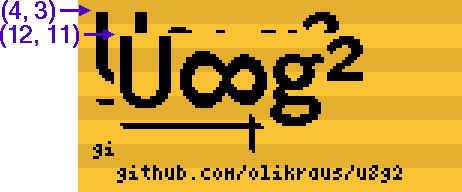
u8g2.setDrawColor(1);
u8g2.setBitmapMode(1);
u8g2.drawXBM(4,3, u8g2_logo_97x51_width, u8g2_logo_97x51_height, u8g2_logo_97x51_bits);
u8g2.drawXBM(12,11, u8g2_logo_97x51_width, u8g2_logo_97x51_height, u8g2_logo_97x51_bits);
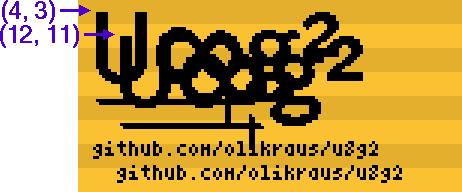
- C++/Arduino Prototype:
void U8G2::setBusClock(uint32_t clock_speed);
-
Description: Arduino environment only: Assign the bus clock speed (frequency) for I2C and SPI. Default values will be used if this function is not called. This command must be placed before the first call to u8g2.begin() or u8g2.initDisplay().
-
Arguments:
-
clock_speed: I2C or SPI bus clock frequency (in Hz)
-
-
Returns: -
-
See also: begin
-
Note 1: Default bus speed values allow reliable use of the most slowest displays. On the other side a specific display may support higher bus clock speed. For example the SSD1327 defaults to 100KHz for I2C, but seems to support 400KHz in many cases. It is a good idea to test higher bus clock values in the current application. For I2C use "u8g2.setBusClock(200000);" or "u8g2.setBusClock(400000);". For SPI try values between "u8g2.setBusClock(1000000);" and "u8g2.setBusClock(8000000);".
-
Note 2: U8g2 will always assign the best bus clock for the current display. However, if there are multiple clients on an I2C bus, then it might happen, that the selected I2C speed is too high for other devices. In this case, force U8g2 to use the speed which is acceptable for all clients: For example try "u8g2.setBusClock(100000);" which should work for all devices.
- C++/Arduino Prototype:
void U8G2::setClipWindow(u8g2_uint_t x0, u8g2_uint_t y0, u8g2_uint_t x1, u8g2_uint_t y1 );
- C Prototype:
void u8g2_SetClipWindow(u8g2_t *u8g2, u8g2_uint_t x0, u8g2_uint_t y0, u8g2_uint_t x1, u8g2_uint_t y1 );
-
Description: Restricts all graphics output to the specified range.
The range is defined from
x0(included) tox1(excluded) andy0(included) toy1(excluded). Use setMaxClipWindow to restore writing to the complete window. -
Arguments:
-
u8g2: A pointer to the u8g2 structure. -
x0: Left edge of the visible area. -
y0: Upper edge of the visible area. -
x1: Right edge +1 of the visible area. -
y1: Lower edge +1 of the visible area.
-
- Returns: -
- See also: setMaxClipWindow
- Example:
u8g2.setClipWindow(10, 10, 85, 30);
u8g2.setDrawColor(1);
u8g2.drawStr(3, 32, "U8g2");
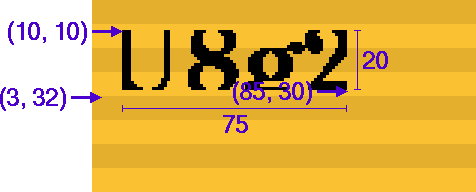
- C++/Arduino Prototype:
void U8G2::setContrast(uint8_t value)
- C Prototype:
void u8g2_SetContrast(u8g2_t *u8g2, uint8_t value);
- Description: Set the contrast or brightness for the display (if supported). Range for 'value': 0 (no contrast) to 255 (maximum contrast or brightness).
-
Arguments:
-
u8g2: A pointer to the u8g2 structure. -
value: Contrast or brightness from 0 to 255.
-
- Returns: -
- See also: -
- C++/Arduino Prototype:
void U8G2::setCursor(u8g2_uint_t x, u8g2_uint_t y)
- Description: Define the cursor for the print function. Any output of the print function will start at this position.
-
Arguments:
-
x,y: Pixel position for the cursor of the print function.
-
- Returns: -
- See also: -
- See also: print home
- Example:
u8g2.setFont(u8g2_font_ncenB14_tr);
u8g2.setCursor(0, 15);
u8g2.print("Hello World!");

- C++/Arduino Prototype:
void setDisplayRotation(const u8g2_cb_t *u8g2_cb)
- C Prototype:
void u8g2_SetDisplayRotation(u8g2_t *u8g2, const u8g2_cb_t *u8g2_cb);
-
Description: Changes the display rotation. Usually the rotation is
defined as part of the U8g2 constructor. The argment
u8g2_cbcan be one of the following values:
u8g2_cb |
Description |
|---|---|
U8G2_R0 |
No rotation, landscape |
U8G2_R1 |
90 degree clockwise rotation |
U8G2_R2 |
180 degree clockwise rotation |
U8G2_R3 |
270 degree clockwise rotation |
U8G2_MIRROR |
No rotation, landscape, display content is mirrored (v2.6.x) |
U8G2_MIRROR_VERTICAL |
Display content is vertically mirrored (v2.29.x) |
-
Arguments:
-
u8g2: A pointer to the u8g2 structure. -
u8g2_cb: Display rotation argument.
-
- Returns: -
- See also: -
- C++/Arduino Prototype:
void U8G2::setDrawColor(uint8_t color)
- C Prototype:
void u8g2_SetDrawColor(u8g2_t *u8g2, uint8_t color);
-
Description: Defines the bit value (color index) for all drawing functions.
All drawing function will change the display memory to this bit value. Default value is 1.
For example the drawBox procedure will set all
pixels for the defined area to the bit value, provided here. In v2.11 the new color
value 2 will activate the XOR mode.
Exceptions:
-
clear, clearBuffer: Both
functions will always set the buffer to the pixel value 0. The
colorargument ofsetDrawColoris ignored. -
drawGlyph: All font drawing procedures
will use this
colorargument as foreground color. In none-transparent (solid) mode (setFontMode) the complement of the color value will be the background color and is set to 0 for color value 2 (However, suggestion is not to use solid and XOR mode together):
-
clear, clearBuffer: Both
functions will always set the buffer to the pixel value 0. The
| Font Mode | Draw Color | Glyph Foreground Color | Glyph Background Color |
|---|---|---|---|
| 0: solid | 0 | 0 | 1 |
| 0: solid | 1 | 1 | 0 |
| 0: solid | 2 | XOR | 0 |
| 1: transparent | 0 | 0 | - |
| 1: transparent | 1 | 1 | - |
| 1: transparent | 2 | XOR | - |
-
Arguments:
-
u8g2: A pointer to the u8g2 structure. -
color: 0 (clear pixel value in the display RAM), 1 (set pixel value) or 2 (XOR mode)
-
- Returns: -
- Note: Not all graphics procedures will support XOR mode. Especially XOR mode is not supported by drawCircle, drawDisc, drawEllipse and drawFilledEllipse.
- See also: drawBox drawGlyph setFontMode
- Example 1: String on background pattern with color values 0 and 1 in transparent mode:
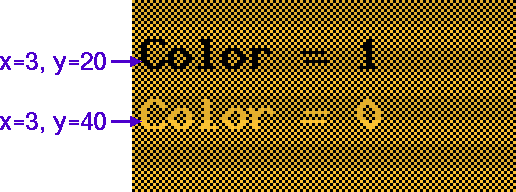
- Example 2: Transparent font mode with different color values:
u8g2.setFontMode(1); /* activate transparent font mode */
u8g2.setDrawColor(1); /* color 1 for the box */
u8g2.drawBox(22, 2, 35, 50);
u8g2.setFont(u8g2_font_ncenB14_tf);
u8g2.setDrawColor(0);
u8g2.drawStr(5, 18, "abcd");
u8g2.setDrawColor(1);
u8g2.drawStr(5, 33, "abcd");
u8g2.setDrawColor(2);
u8g2.drawStr(5, 48, "abcd");
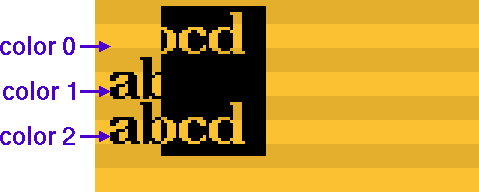
- C++/Arduino Prototype:
void U8G2::setFlipMode(uint8_t is_enable)
- C Prototype:
void u8g2_SetFlipMode(u8g2_t *u8g2, uint8_t is_enable);
- Description: Some displays support a 180 degree rotation of the internal frame buffer. This hardware feature can be controlled with this procedure. Important: Redraw the complete display after changing the flip mode. Best is to clear the display first, then change the flip mode and finally redraw the content. Results will be undefined for any existing content on the screen.
-
Arguments:
-
u8g2: A pointer to the u8g2 structure. -
is_enable: Enable (1) or disable (0) 180 degree rotation of the display content
-
- Returns: -
- See also: -
- C++/Arduino Prototype:
void U8G2::setFont(const uint8_t *font)
- C Prototype:
void u8g2_SetFont(u8g2_t *u8g2, const uint8_t *font);
- Description: Define a u8g2 font for the glyph and string drawing functions. Note: u8x8 font can NOT be used. Available fonts are listed here. The last two characters of the font name define the type and character set for the font:
| Font Name | Font Type |
|---|---|
| u8g2_xxx_tx | Transparent gylphs with variable width |
| u8g2_xxx_mx | Monospace/fixed width glyphs |
| u8g2_xxx_hx | Glyphs with variable width and common height |
| u8g2_xxx_8x | Monospace/fixed width glyphs in a 8x8 box |
| Font Name | Character Set |
|---|---|
| u8g2_xxx_xe | Extended: Glyphs with unicode 32 to 701 are included in the font (v2.16.x will also include big ß) |
| u8g2_xxx_xf | Full: Glyphs with unicode 32 to 255 are included in the font |
| u8g2_xxx_xr | Restricted: Only characters from 32 to 127 are included |
| u8g2_xxx_xu | Uppercase: Numbers and uppercase letters |
| u8g2_xxx_xn | Numbers and some extra glyphs for date and time printing are included |
| u8g2_xxx_x_something | Special selection of glyphs. See the font picture for details. |
-
Arguments:
-
u8g2: A pointer to the u8g2 structure. -
font: Point to a u8g2 font. A list of available fonts is here.
-
- Returns: -
- See also: drawUTF8 drawStr drawGlyph List of u8g2 fonts
-
Example: Fonts
u8g2_font_5x7_trandu8g2_font_pressstart2p_8u
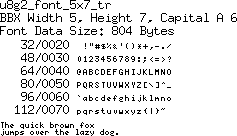

- C++/Arduino:
void U8G2::setFontDirection(uint8_t dir)
- C:
void u8g2_SetFontDirection(u8g2_t *u8g2, uint8_t dir)
- Description: The arguments defines the drawing direction of all strings or glyphs.
| Argument | String Rotation | Description |
|---|---|---|
| 0 | 0 degree | Left to right |
| 1 | 90 degree | Top to down |
| 2 | 180 degree | Right to left |
| 3 | 270 degree | Down to top |
-
Arguments:
-
u8g2: Pointer to theu8g2structure (C interface only). -
dir: Writing direction/string rotation.
-
- Returns:
- See also: drawStr
- Example:
u8g2.setFont(u8g2_font_ncenB14_tf);
u8g2.setFontDirection(0);
u8g2.drawStr(15, 20, "Abc");
u8g2.setFontDirection(1);
u8g2.drawStr(15, 20, "Abc");
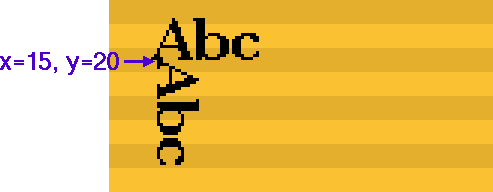
- C++/Arduino Prototype:
void U8G2::setFontMode(uint8_t is_transparent)
- C Prototype:
void u8g2_SetFontMode(u8g2_t *u8g2, uint8_t is_transparent);
-
Description: Defines, whether the glyph and string drawing functions will
write the background color (mode 0/solid,
is_transparent = 0) or not (mode 1/transparent,is_transparent = 1). Default mode is 0 (background color of the characters is overwritten). -
Arguments:
-
u8g2: A pointer to the u8g2 structure. -
is_transparent: Enable (1) or disable (0) transparent mode.
-
- Returns: -
- Note: Always choose a suitable font, depending on the font mode:
| Font Name | Font Type | Suitable for... |
|---|---|---|
| u8g2_xxx_tx | Transparent gylphs with variable width |
is_transparent = 1, XOR Mode |
| u8g2_xxx_mx | Monospace/fixed width glyphs | is_transparent = 0 |
| u8g2_xxx_hx | Glyphs with variable width and common height | is_transparent = 0 |
| u8g2_xxx_8x | Monospace/fixed width glyphs in a 8x8 box | is_transparent = 0 |
- See also: setDrawColor setFont
- Example: This example shows four combinations with the color value 0 and 1 (setDrawColor).
/* write background pattern, then: */
u8g2.setFontMode(0);
u8g2.setDrawColor(1);
u8g2.drawStr(3, 15, "Color=1, Mode 0");
u8g2.setDrawColor(0);
u8g2.drawStr(3, 30, "Color=0, Mode 0");
u8g2.setFontMode(1);
u8g2.setDrawColor(1);
u8g2.drawStr(3, 45, "Color=1, Mode 1");
u8g2.setDrawColor(0);
u8g2.drawStr(3, 60, "Color=0, Mode 1");
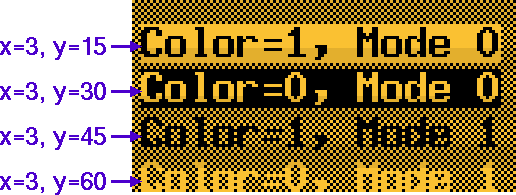
- C++/Arduino Prototype:
void U8G2::setFontPosBaseline(void)
void U8G2::setFontPosBottom(void)
void U8G2::setFontPosTop(void)
void U8G2::setFontPosCenter(void)
- C Prototype:
void u8g2_SetFontPosBaseline(u8g2_t *u8g2);
void u8g2_SetFontPosBottom(u8g2_t *u8g2);
void u8g2_SetFontPosTop(u8g2_t *u8g2);
void u8g2_SetFontPosCenter(u8g2_t *u8g2);
- Description: Change the reference position for the glyph and string draw functions. By default the reference position is "Baseline".
-
Arguments:
-
u8g2: A pointer to the u8g2 structure.
-
- Returns: -
- See also: drawUTF8 drawStr drawGlyph
- Example:
u8g2.setFont(u8g2_font_ncenB18_tf); // change ref pos to vertical center of the font
u8g2.setFontPosCenter();
u8g2.drawStr(5, 20, "Agi");
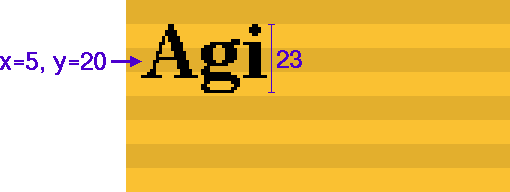
- C++/Arduino:
void U8G2::setFontRefHeightAll(void)
void U8G2::setFontRefExtendedHeightText(void)
void U8G2::setFontRefHeightText(void)
- C:
void u8g2_SetFontRefHeightAll(u8g2_t *u8g2)
void u8g2_SetFontRefHeightExtendedText(u8g2_t *u8g2)
void u8g2_SetFontRefHeightText(u8g2_t *u8g2)
-
Description: A call to one of these procedure will define the calculation
method for the ascent and descent of the current font.
This method will be used for the current and all other fonts,
which will be set with
setFont(). Changing this calculation method has an effect ongetAscent()andgetDescent(). Default issetFontRefHeightText().-
setFontRefHeightAll: Ascent will be the highest ascent of all glyphs of the current font. Descent will be the highest descent of all glyphs of the current font. -
setFontRefHeightExtendedText: Ascent will be the largest ascent of "A", "1" or "(" of the current font. Descent will be the descent of "g" or "(" of the current font. -
setFontRefHeightText: Ascent will be the ascent of "A" or "1" of the current font. Descent will be the descent "g" of the current font (this is the default after startup).
-
-
Arguments:
-
u8g2: Pointer to theu8g2structure (C interface only).
-
- Returns:
- See also: getAscent getDescent
- C++/Arduino Prototype:
void U8G2::setI2CAddress(uint8_t adr)
- C Prototype:
void u8g2_SetI2CAddress(u8g2_t *u8g2, uint8_t adr)
- Description: By default, U8g2 assumes the lowest possible I2C address of the display. This procedure will assign the I2C address to u8g2, if the display is configured to a different address. Call this procedure before begin().
-
Arguments:
-
u8g2: A pointer to the u8g2 structure. -
adr: I2C address multiplied with 2 (the lowest bit must be zero)
-
- Returns: -
- See also: begin
- Note: This procedure is available with U8g2 v2.6.x
- C++/Arduino Prototype:
void U8G2::setMaxClipWindow(void)
- C Prototype:
void u8g2_SetMaxClipWindow(u8g2_t *u8g2);
- Description: Removes the effect of setClipWindow. Graphics is written to the complete display.
-
Arguments:
-
u8g2: A pointer to the u8g2 structure.
-
- Returns: -
- See also: setClipWindow
- C++/Arduino Prototype:
void U8G2::setPowerSave(uint8_t is_enable)
- C Prototype:
void u8g2_setPowerSave(u8g2_t *u8g2, uint8_t is_enable)
-
Description: Activates (
is_enable = 1) or disables (is_enable = 0) the power save mode of the display. With activated power save mode, nothing will be visible on the display. The content of the RAM of the display is not changed. This procedure is also called from begin. -
Arguments:
-
u8g2: A pointer to the u8g2 structure. -
is_enable: Enable (1) or disable (0) power save mode for the display.
-
- Returns: -
- See also: begin
- C++/Arduino Prototype:
void U8G2::updateDisplay(void)
void U8G2::updateDisplayArea(uint8_t tx, uint8_t ty, uint8_t tw, uint8_t th)
- C Prototype:
void u8g2_UpdateDisplay(u8g2_t *u8g2)
void u8g2_UpdateDisplayArea(u8g2_t *u8g2, uint8_t tx, uint8_t ty, uint8_t tw, uint8_t th)
-
Description: Updates all or the specified rectangle area of the display.
The member function
updateDisplay()is almost identical tosendBuffer(). Member functionupdateDisplayArea()will update the specified rectangle area: Only the specified area is copied from the internal buffer to the display. The area has to be specified in tiles. One tile is a 8x8 pixel area. To get the pixel value, multiply the tile value with 8 (forU8G2_R0). The tile coordinates are independent from the applied rotation in the U8g2 constructor but have the same orientation asU8G2_R0. For other rotations the calculation between pixel value tile position is more complicated. The three member functionssendBuffer,updateDisplayandupdateDisplayAreaare designed for the full buffer mode (constructor with_F_in the name). HoweversendBufferandupdateDisplaycan be used in page mode also. IfupdateDisplayis used together with ePaper displays, ensure that a proper refresh sequence is send to the display. Differences betweensendBuffer,updateDisplayandupdateDisplayArea:
| Behavior/Feature | sendBuffer |
updateDisplay |
updateDisplayArea |
|---|---|---|---|
| Sends a refreshDisplay message | yes | no | no |
| Works in full buffer mode | yes | yes | yes |
| Works in page buffer mode | yes | yes | no |
-
Arguments:
-
u8g2: A pointer to the u8g2 structure. -
tx,ty: Upper left corner of the area, given as tile position. -
tw,th: Width and height of the area in tiles.
-
- Returns: -
-
Note 1:
updateDisplay()will work for all display controllers.updateDisplayArea()will not fully work for the following controllers: SH1122, LD7032, ST7920, ST7986, LC7981, T6963, SED1330, RA8835, MAX7219, LS0xx -
Note 2: Range for
tx:0..getBufferTileWidth()-1and forty:0..getBufferTileHeight()-1. There is no overflow check. The area must fully fit into the display area. Especially the following conditions must be true:tx+tw <= getBufferTileWidth()andty+th <= getBufferTileHeight(). -
Note 3:
setClipWindowvsupdateDisplayArea: Both may generate similar visual effects, however...-
setClipWindow- Pixel coordinates
- Used within the firstPage/nextPage loop
- Valid for full and page buffer mode
- Will limit the number of pixel drawn into the buffer
- Performance increase due to lesser pixel painting
- Will work with any rotation command in the constructor
- Will work with any setting for
u8g2.setFlipMode()
-
updateDisplayArea- Tile coordinates
- Must be used outside the firstPage/nextPage loop
- Valid only for full buffer mode
- Will limit the data transfer to the display
- Performance increase due to lesser data transfer to the display
- Will work with any rotation command in the constructor, but requires more complicated calculation for the tile coordinates if the rotation is not
U8G2_R0. - Will work with any setting for
u8g2.setFlipMode()
-
- Note 4: More discussion happend here: https://github.com/olikraus/u8g2/issues/736
- Example: https://github.com/olikraus/u8g2/blob/master/sys/arduino/u8g2_full_buffer/UpdateArea/UpdateArea.ino
- See also: sendBuffer, getBufferTileHeight, getBufferTileWidth, setClipWindow
- C++/Arduino Prototype:
uint8_t U8G2::userInterfaceInputValue(const char *title, const char *pre, uint8_t *value, uint8_t lo, uint8_t hi, uint8_t digits, const char *post) {
- C Prototype:
uint8_t u8g2_UserInterfaceInputValue(u8g2_t *u8g2, const char *title, const char *pre, uint8_t *value, uint8_t lo, uint8_t hi, uint8_t digits, const char *post);
- Description: Requests the input of a 8-bit value. All display output and key processing is done inside this function.
-
Arguments:
-
u8g2: A pointer to the u8g2 structure. -
title: Multiline description for the value (Lines have to be separated with\n). -
pre: Text before thevalue. -
value: A pointer to a variable which will be filled with the input from the user. -
lo: Lowest value, which can be selected by the user. -
hi: Highest value, which can be selected by the user. -
digits: Number of digits (1 to 3). -
post: Text after thevalue.
-
-
Returns: 1, if the user has pressed the select button. 0 if the user has pressed the home/cancel button.
The selected value will be stored in
valueonly if the user has pressed the select key. - See also: begin
- Example:
u8g2.userInterfaceInputValue("Select Voltage", "DAC= ", &v, 0, 5, 1, " V");
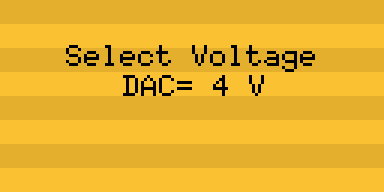
- C++/Arduino Prototype:
uint8_t U8G2::userInterfaceMessage(const char *title1, const char *title2, const char *title3, const char *buttons)
- C Prototype:
uint8_t u8g2_UserInterfaceMessage(u8g2_t *u8g2, const char *title1, const char *title2, const char *title3, const char *buttons);
- Description: Displays a message text and wait for user input. The user can press one button or select between two or more buttons.
-
Arguments:
-
u8g2: A pointer to the u8g2 structure. -
title1: First multiline description (Lines have to be separated with\n). -
title2: Second singleline description (One line is drawn until first\nor\0). -
title3: Third multiline description (Lines have to be separated with\n). -
button: One or more buttons, separated with\n.
-
- Returns: 1 to n for if one of the buttons had been selected. 0 if the user has pressed the home/cancel button.
- See also: begin
- Example:
u8g2.setFont(u8g2_font_6x10_tf);
u8g2.setFontRefHeightAll(); /* this will add some extra space for the text inside the buttons */
u8g2.userInterfaceMessage("Title1", "Title2", "Title3", " Ok \n Cancel ");

- C++/Arduino Prototype:
uint8_t U8G2::userInterfaceSelectionList(const char *title, uint8_t start_pos, const char *sl)
- C Prototype:
uint8_t u8g2_UserInterfaceSelectionList(u8g2_t *u8g2, const char *title, uint8_t start_pos, const char *sl)
- Description: Display a list of scrollable and selectable options. The user can select one of the options.
-
Arguments:
-
u8g2: A pointer to the u8g2 structure. -
start_pos: The element, which is highlighted first (starts with 1). -
sl: List of options, one per line (Lines have to be separated with\n).
-
- Returns: 1 to n for if one of the buttons had been selected. 0 if the user has pressed the home/cancel button.
- See also: begin
- Example:
u8g2.userInterfaceSelectionList("Title", 2, "abcdef\nghijkl\nmnopqr");

- C++/Arduino Prototype:
void U8G2::writeBufferPBM(Print &p)
void U8G2::writeBufferPBM2(Print &p)
void U8G2::writeBufferXBM(Print &p)
void U8G2::writeBufferXBM2(Print &p)
- C Prototype:
void u8g2_WriteBufferPBM(u8g2_t *u8g2, void (*out)(const char *s))
void u8g2_WriteBufferXBM(u8g2_t *u8g2, void (*out)(const char *s))
void u8g2_WriteBufferPBM2(u8g2_t *u8g2, void (*out)(const char *s))
void u8g2_WriteBufferXBM2(u8g2_t *u8g2, void (*out)(const char *s))
-
Description: Writes the content of the u8g2 buffer to the specified object (Arduino/C++)
or callback function (plain C interface). This function can be used to implement
a screenshot/screencapture feature.
The output format is XBM or
PBM. Both formats are plain
ASCII image descriptions: If the image is written to a destination terminal (for
example the Serial Monitor of the Arduino IDE), just copy
the output into a text file with the extensions ".xbm" or ".pbm".
This command writes content the current memory. To get output the complete
display image U8G2 must be used in full buffer
mode (Constructor with
_F_, see also sendbuffer). There are two internal memory architectures. Depending on the controller type, a different screenshot procedure is required:
| Procedure | Format | Display Controller |
|---|---|---|
| writeBufferPBM2 | Portable Bitmap | SH1122, LD7032, ST7920, ST7986, LC7981, T6963, SED1330, RA8835, MAX7219, LS0xx |
| writeBufferXBM2 | X Bitmap | SH1122, LD7032, ST7920, ST7986, LC7981, T6963, SED1330, RA8835, MAX7219, LS0xx |
| writeBufferPBM | Portable Bitmap | All other controller not mentioned above |
| writeBufferXBM | X Bitmap | All other controller not mentioned above |
-
Arguments:
-
u8g2: A pointer to the u8g2 structure. -
p: Object derived from the Arduino Print class (for example "Serial" for output to the Arduino Serial Monitor). -
out: A C function which will receive a'\0'termanted string. This function should redirect the image description to a connected terminal.
-
- Returns: -
- See also: begin
-
Note 1: These procedures will only work in U8G2 full buffer mode (constructor with
_F_) - Note 2: Available with version 2.27.x
- Example: full_buffer/ScreenShot.ino
This API is available with U8g2 version 2.7.x.
The section includes commands for direct access to the internal buffer. This direct access to the internal pixel memory is usually not required.
- The following functions provide direct access to the internal pixel buffer.
- The internal pixel buffer has the same structure as the target display. Any modification of the internal pixel buffer will not be portable (however all controller with support for the U8x8 interface have the same memory structure).
- Arduino example: "DirectAccess.ino" from the page buffer example section.
All display controller with support for the U8x8 interface share the same memory structure:
| Tile 0 | Tile 0 | Tile 0 | Tile 0 | Tile 0 | Tile 0 | Tile 0 | Tile 0 | Tile 1 | Tile 1 | ... |
|---|---|---|---|---|---|---|---|---|---|---|
| Byte 0 | Byte 1 | Byte 2 | Byte 3 | Byte 4 | Byte 5 | Byte 6 | Byte 7 | Byte 8 | Byte 9 | ... |
| Bit 0 | Bit 0 | Bit 0 | Bit 0 | Bit 0 | Bit 0 | Bit 0 | Bit 0 | Bit 0 | Bit 0 | ... |
| Bit 1 | Bit 1 | Bit 1 | Bit 1 | Bit 1 | Bit 1 | Bit 1 | Bit 1 | Bit 1 | ... | |
| Bit 2 | Bit 2 | Bit 2 | Bit 2 | Bit 2 | Bit 2 | Bit 2 | Bit 2 | ... | ||
| Bit 3 | Bit 3 | Bit 3 | Bit 3 | Bit 3 | Bit 3 | Bit 3 | Bit 3 | ... | ||
| Bit 4 | Bit 4 | Bit 4 | Bit 4 | Bit 4 | Bit 4 | Bit 4 | Bit 4 | ... | ||
| Bit 5 | Bit 5 | Bit 5 | Bit 5 | Bit 5 | Bit 5 | Bit 5 | Bit 5 | ... | ||
| Bit 6 | Bit 6 | Bit 6 | Bit 6 | Bit 6 | Bit 6 | Bit 6 | Bit 6 | ... | ||
| Bit 7 | Bit 7 | Bit 7 | Bit 7 | Bit 7 | Bit 7 | Bit 7 | Bit 7 | ... |
The memory structure for these displays is organized as tiles:
- One tile contains 8x8 = 64 pixel. These are 8 Bytes.
- A constructor with
_1_in its name, has a buffer which contains one row of tiles. - A constructor with
_2_in its name, has a buffer which contains two rows of tiles. - For the above memory structure, the pixel position and the tile row/column can be calculated by multiplying the tile row and tile column with 8 to get the x and y position.
- In the above memory structure the pixel at x=2 and y=1 is marked italic.
- A "page" is a memory buffer which corresponds to a specific tile row on the display.
- A "page" has a current top row position.
- C++/Arduino Prototype:
uint16_t U8G2::getBufferSize()
- C Prototype:
uint16_t u8g2_GetBufferSize(u8g2_t *u8g2)
- Description: Return the size of the page buffer that is required for the currently display type. The return value is equivalent to 8 * u8g2.getBufferTileHeight() * u8g2.getBufferTileWidth().
-
Arguments:
-
u8g2: A pointer to the u8g2 structure.
-
- Returns: The size of the page buffer
- See also: getBufferTileHeight, getBufferTileWidth
- C++/Arduino Prototype:
void *U8G2::setBufferPtr(uint8_t *buf)
- C Prototype:
void u8g2_SetBufferPtr(u8g2_t *u8g2, uint8_t *buf)
- Description: Set the address of the start of the buffer. This is also the address of the leftmost tile of the current page (Byte 0 in the above memory structure). The total memory size of the buffer is 8 * u8g2.getBufferTileHeight() * u8g2.getBufferTileWidth(). The size may also be received by calling u8g2.getBufferSize(). The Buffer can be erased with u8g2.clearBuffer().
-
Arguments:
-
u8g2: A pointer to the u8g2 structure. -
buf: A pointer to the start of the internal page buffer.
-
- Returns: -
- See also: getBufferTileHeight, getBufferTileWidth, clearBuffer, getBufferSize
- C++/Arduino Prototype:
uint8_t *U8G2::getBufferPtr(void)
- C Prototype:
uint8_t *u8g2_GetBufferPtr(u8g2_t *u8g2)
- Description: Return the address of the start of the buffer. This is a also the address of the leftmost tile of the current page (Byte 0 in the above memory structure). The total memory size of the buffer is 8 * u8g2.getBufferTileHeight() * u8g2.getBufferTileWidth(). The size may also be received by calling u8g2.getBufferSize(). The buffer can be erased with u8g2.clearBuffer().
-
Arguments:
-
u8g2: A pointer to the u8g2 structure.
-
- Returns: Address of the internal page buffer.
- See also: getBufferTileHeight, getBufferTileWidth, clearBuffer, getBufferSize
- C++/Arduino Prototype:
uint8_t U8G2::getBufferTileHeight(void)
- C Prototype:
uint8_t u8g2_GetBufferTileHeight(u8g2_t *u8g2)
- Description: Return the height of the page buffer in tiles. The height of one tile is 8 pixel.
-
Arguments:
-
u8g2: A pointer to the u8g2 structure.
-
- Returns: The height of the buffer in tiles.
- See also: getBufferPtr, getBufferTileWidth
- C++/Arduino Prototype:
uint8_t U8G2::getBufferTileWidth(void)
- C Prototype:
uint8_t u8g2_GetBufferTileWidth(u8g2_t *u8g2)
- Description: Return the width of the page buffer in tiles (One tile has a width of 8 pixel).
-
Arguments:
-
u8g2: A pointer to the u8g2 structure.
-
- Returns: The width of the buffer in tiles.
- See also: getBufferPtr, getBufferTileHeight
- C++/Arduino Prototype:
uint8_t U8G2::getBufferCurrTileRow(void)
- C Prototype:
uint8_t u8g2_getBufferCurrTileRow(u8g2_t *u8g2)
- Description: Return the intended position for the content of the pixel buffer (page) on the target display. If it is assumed, that the buffer will be placed at the top of the display, then this value is zero. This value is modified by firstPage/nextPage and used by sendBuffer to place the content of the pixel buffer at the target position.
-
Arguments:
-
u8g2: A pointer to the u8g2 structure.
-
- Returns: The current page position in tiles (one tile has a height of 8 pixel)
- See also: getBufferPtr.
- C++/Arduino Prototype:
void U8G2::setBufferCurrTileRow(uint8_t row)
- C Prototype:
void u8g2_setBufferCurrTileRow(u8g2_t *u8g2, uint8_t row)
-
Description: Set the position of the pixel buffer for the sendBuffer command and also sets the area into which all the graphics commands write.
-
Arguments:
-
u8g2: A pointer to the u8g2 structure. -
row: Location for the pixel buffer on the display.rowis the "tile" position and must be multiplied with 8 to get the pixel position.
-
-
Returns: -
-
Note: Never use this command inside of the firstPage/nextPage loop. It may cause an infinite loop if the current position is modified.
-
See also: getBufferPtr, sendBuffer.
-
Example: The examples shows how to update single tile rows (8 pixel height) on the display and how to copy this row multiple times to different row positions. The example also assumes, that the page hight is 8 pixel (
_1_constructor). In the first part,setBufferCurrTileRowis used to define which y values are placed in the buffer. Withrow = 0pixel with y values from 0 to 7 will be visible. Note that the lower lettergis not visible : The lower part of the lower lettergis placed at pixel line y=8. Once the buffer is filled, the buffer content is sent to row 2 (pixel lines 16..23) and tile row 4 (pixel lines 32..39). Especially the buffer is not sent to row 0, so the text does not appear in the lines 0..7 (although drawStr has placed it there).
u8g2.setBufferCurrTileRow(0); // let y=0 be the topmost row of the buffer
u8g2.clearBuffer();
u8g2.setFont(u8g2_font_helvB08_tr);
u8g2.drawStr(2, 8, "abcdefg");
u8g2.setBufferCurrTileRow(2); // write the buffer to tile row 2 (y=16) on the display
u8g2.sendBuffer();
u8g2.setBufferCurrTileRow(4); // write the same buffer to tile row 4 (y=32) on the display
u8g2.sendBuffer();
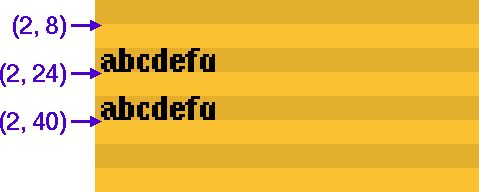
- Example 2: See here: UpdatePartly/UpdatePartly.ino
